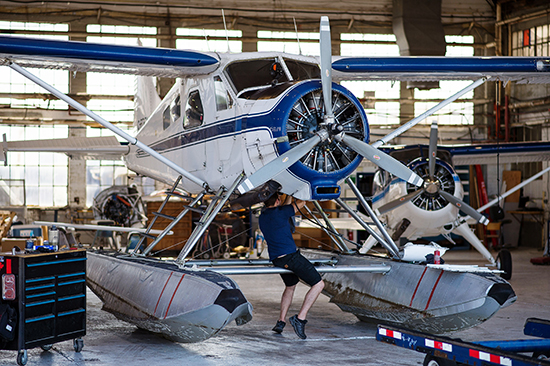這種飛機(jī)可能顛覆運(yùn)輸業(yè)

?
|
從科幻角度來說,德哈維蘭加拿大公司(de Havilland Canada)的DHC-2海貍飛機(jī),,一點(diǎn)都沒有未來感:矮壯的機(jī)翼,、結(jié)實(shí)的機(jī)身和兩個(gè)肥大的浮筒。這款飛機(jī)在1947年首飛,。 不過,,當(dāng)一架海貍飛機(jī)在本周二早晨從溫哥華港起飛時(shí),許多航空業(yè)內(nèi)人士卻稱,,這就是商業(yè)航空的未來,。因?yàn)槭飞鲜状危患茌d有付費(fèi)乘客的飛機(jī)使用電動(dòng)馬達(dá)起飛了,。 初創(chuàng)公司MagniX的Magni500電動(dòng)馬達(dá)為這架海貍飛機(jī)提供動(dòng)力,,該飛機(jī)隸屬于總部設(shè)在溫哥華的加拿大港灣航空公司(Harbour Air),。這家小型航空公司的主管格雷格·麥克道加爾駕駛這架飛機(jī)開始了在水面上空的短暫航程,然后他讓飛機(jī)平穩(wěn)地在港口降落,,并將飛機(jī)緩緩開到碼頭,,在那里,一群觀看此次飛行的人們歡呼雀躍,。 有許多裝了電動(dòng)馬達(dá)的飛機(jī)曾經(jīng)試飛過,,但港灣航空是第一家將業(yè)務(wù)押注在電動(dòng)馬達(dá)上的航空公司。它希望監(jiān)管者能夠在兩年內(nèi)認(rèn)可這架改型了的飛機(jī),,并在2022年開始商業(yè)飛行,。 多年來,航空業(yè)一直在討論電動(dòng)飛機(jī)的商業(yè)飛行是否可行,。周二的試飛似乎在說“這是真實(shí)可行的,,”MagniX的首席執(zhí)行官羅伊·甘查爾斯基告訴《財(cái)富》雜志,“這是一家飛著自己造的飛機(jī)的航空公司,?!?/p> 港灣航空是一家小型航空公司,擁有42架水上飛機(jī),,飛行線路環(huán)繞不列顛哥倫比亞省的喬治海峽,。 MagniX還在與其他航空公司會(huì)談,盡管依照保密協(xié)議,,甘查爾斯基拒絕透露有幾家,。“毫不疑問,,有很多會(huì)談在進(jìn)行中,。”他說,。 改裝飛機(jī),,是MagniX的雙管齊下戰(zhàn)略的一部分,,以便在日益擁擠的電動(dòng)馬達(dá)市場(chǎng)確立領(lǐng)導(dǎo)地位,。公司三款較小的Magni250馬達(dá),將安裝在位于以色列的Eviation公司的愛麗絲飛機(jī)上,,這款飛機(jī)專為電動(dòng)馬達(dá)動(dòng)力而設(shè)計(jì),,可以容納9名乘客。 Eviation和MagniX的所有者,,均為新加坡的克萊蒙特集團(tuán)(Clermont Group),,而該集團(tuán)的所有者理查德·錢德勒,一向以長期投資而知名,。甘查爾斯基說,,克萊蒙特為MagniX提供足量資金,,使其免于依賴不確定的數(shù)輪融資。 據(jù)美國證券交易委員會(huì)的文檔顯示,,今年1月,,克萊蒙特向Eviation投了7600萬美元,獲得70%的股權(quán),。甘查爾斯基在11月被任命為Eviation的董事會(huì)主席,。 今年6月在巴黎空展上,總部位于馬薩諸塞州的海角航空(Cape Air)下了首批愛麗絲飛機(jī)的訂單,,預(yù)計(jì)將于2020年首飛,,并在兩年后進(jìn)行商業(yè)飛行。這款時(shí)髦的飛機(jī)預(yù)計(jì)能夠用電動(dòng)動(dòng)力飛行近600英里,,與之相比經(jīng)改裝的海貍航程只有100英里,。 但一碼歸一碼,電池組的能量遠(yuǎn)少于航空燃油,,航空燃油攜帶的能量是電池組的40倍,,這意味著港灣航空的海貍飛機(jī)上,只要有空間的地方都得裝電池,,甘查爾斯基說,。 考慮到電池的低能量密度,全世界范圍要見到全電動(dòng)的地區(qū)性和大型商業(yè)航班,,可能還需要數(shù)十年,,這是航空咨詢師本瓊·費(fèi)赫姆為網(wǎng)站“利厄姆新聞與分析”(Leeham News and Analysis)撰文時(shí)提到的,這家新的網(wǎng)站是由西雅圖區(qū)域的航空咨詢公司利厄姆(Leeham)運(yùn)營的,。 混合動(dòng)力航班可能會(huì)先于全電動(dòng)航班普及,。空客(Airbus)就在考慮將單過道機(jī)型A320改造成混合動(dòng)力飛機(jī),。這家歐洲航空公司尚處于考慮未來飛機(jī)的初級(jí)概念階段,,而未來的飛機(jī)預(yù)計(jì)將在2030年中期全面鋪開??湛偷母偁帉?duì)手波音(Boeing),,也在考慮混合動(dòng)力飛機(jī)。波音收購了Zunum Aero公司,,這是一家位于西雅圖的開發(fā)小型客機(jī)的初創(chuàng)企業(yè),。 短途的混合動(dòng)力機(jī)型,比如Zunum的ZA10,,以及全電動(dòng)機(jī)型比如愛麗絲,,都承諾能夠大幅削減運(yùn)營成本。甘查爾斯基預(yù)計(jì),這種航班的成本要比使用化石燃料的航班成本低60%到80%,。 最受歡迎的短途飛機(jī)塞斯納卡拉萬(Cessna Caravan),,飛行100英里,載客9人,,需要耗費(fèi)價(jià)值超過300美元的燃油,。“一架電動(dòng)卡拉萬,,耗電成本大概是6到10美元,。”甘查爾斯基說,。MagniX公司目前正在華盛頓州中部的摩西萊克試飛一架經(jīng)改裝的卡拉萬,。 電動(dòng)馬達(dá)與內(nèi)燃式發(fā)動(dòng)機(jī)相比,維護(hù)成本也更低,,內(nèi)燃式發(fā)動(dòng)機(jī)有很多的運(yùn)動(dòng)部件,,工作環(huán)境也極端得多。一架全電動(dòng)飛機(jī)的啟用,,其初期成本與傳統(tǒng)飛機(jī)相比可能更高,。操作者需要更換電池。更換的頻率是數(shù)年,,要視飛行的頻率而定,,費(fèi)赫姆說。 即便如此,,甘查爾斯基仍然預(yù)計(jì),,到2025年改裝為電動(dòng)動(dòng)力的飛機(jī)將開始在現(xiàn)有的飛行路線上取代化石燃料飛機(jī)。除了更低的運(yùn)營和維護(hù)成本,,他還說,,到2035年“大多數(shù)電動(dòng)飛機(jī)的飛行線路,今天還尚未存在”,。 使用小型電動(dòng)飛機(jī)的航空公司將意識(shí)到,,他們“不再需要美國聯(lián)邦運(yùn)輸安全管理局(TSA)的監(jiān)管,不需要登機(jī)口,。他們只需要一塊降落區(qū)域,,可以充電?!彼f,。 費(fèi)赫姆則不那么樂觀,他寫道,,這個(gè)行業(yè)還處于“預(yù)期膨脹的頂峰”這一初級(jí)階段。(財(cái)富中文網(wǎng)) 譯者:宣峰 |
For a sci-fi airplane, the de Havilland Canada DHC-2 Beaver looks nothing like the future: stubby wings, a burly fuselage and two fat pontoons. It first flew in 1947. Nonetheless, when a Beaver lifted off from Vancouver Harbour Tuesday morning, it signaled what many aerospace industry insiders say is commercial aviation’s future. For the first time, an aircraft that carries paying passengers took off with an electric motor. Startup magniX’s Magni500 electric motor powered the Vancouver-based Harbour Air’s Beaver into the air. The small airline’s chief executive, Greg McDougall, piloted the aircraft during the brief flight over the water, followed by a gentle landing in the harbor. He taxied the plane back to a dock, where a small crowd watching the event cheered. Plenty of electric-powered aircraft have flown, but Harbour Air is the first airline that is betting its business on electric motors. The airline expects regulators to certify its retrofitted aircraft in about two years, with commercial flights beginning in 2022. For years, the aerospace industry has been talking about whether electric-powered commercial air travel is viable. Tuesday’s flight declared “this is real,” MagniX CEO Roei Ganzarski tells Fortune. “This is an airline flying their own aircraft.” Harbour Air is a small airline with 42 small seaplanes flying routes around British Columbia’s Strait of George. MagniX is in talks with other airlines, although Ganzarski declined to say how many, citing confidentiality agreements. “There are definitely a lot of conversations going on,” he says. Retrofitting aircraft is one part of magniX’s two-prong strategy to establish itself as a leader in the increasingly crowded electric motor sector. Three of the company’s smaller Magni250 motors will power Israel-based Eviation’s Alice aircraft, which is specifically designed to be electric-powered and can fit nine passengers. Both Eviation and magniX are owned by Singapore-based Clermont Group, whose owner, Richard Chandler, has a reputation for making long-term investments. Clermont is fully bankrolling magniX, saving the motor maker from depending on uncertain fundraising cycles, Ganzarski says. Clermont put $76 million in Eviation Aircraft in January for a 70% stake, according to a U.S. Securities and Exchange Commission filing. Ganzarski was named chairman of Eviation’s board in November. At the Paris Air Show in June, Massachusetts-based Cape Air placed the first firm order for the Alice, which is expected to first fly in 2020 and to enter service two years later. The sleek aircraft is expected to have a range of nearly 600 miles under electric power compared to the retrofitted Beaver’s 100-mile range. Pound for pound, batteries pack far less energy than aviation fuel, which has as much as 40 times greater energy . That means batteries are stuffed everywhere there is space in Harbour Air’s Beavers, Ganzarski said. Given batteries’ low energy density it likely will be decades before the world sees all-electric regional and large commercial jetliners, aerospace consultant Bjorn Fehrm writes for Leeham News and Analysis, a news site run by the Seattle-area aerospace consulting firm Leeham. Hybrid airliners likely will precede all-electric jetliners. Airbus is considering offering a hybrid option of the successor to its single-aisle A320. The European airplane maker is early in the concept phase for that future aircraft, which is not expected to roll out until the mid-2030s. Airbus’ rival, Boeing, is pursuing hybrid aircraft as well. It acquired Zunum Aero, a Seattle-area startup developing a small passenger plane. In the meantime, short-haul hybrid aircraft, such as Zunum’s ZA10, and all-electric ones like the Alice promise to slash operating costs. Ganzarski expects it to be 60 to 80% cheaper to operate than fossil-fuel aircraft. A 100-mile flight in the nine-passenger Cessna Caravan, one of the most popular short-haul aircraft, costs more than $300 in fuel. “In an electric Caravan, you will spend $6 to $12 on electricity” to charge its batteries, he said. MagniX is currently flight-testing a retrofitted Caravan at Moses Lake in central Washington. Maintenance costs will be lower as well for electric motors compared to internal combustion engines, which have more moving parts creating much more extreme conditions. An all-electric airplane likely will have higher upfront costs compared to traditional planes. Operators will have to replace batteries. That could be as often as every few years, depending on how often the planes fly, according to Fehrm. Even so, Ganzarski expects by 2025 retrofitted electric aircraft will start replacing fossil-fuel planes on existing routes. Given the lower operating and maintenance costs, he says, “the majority of electric aircraft will be flying routes that today don’t exist” by 2035. Airlines using small electric planes will realize they “don’t need TSA, they don’t need gates. They just need a landing strip with charging infrastructure,” he said. Fehrm is not so optimistic. He writes that the industry is still in the initial “peak of inflated expectations.” |













